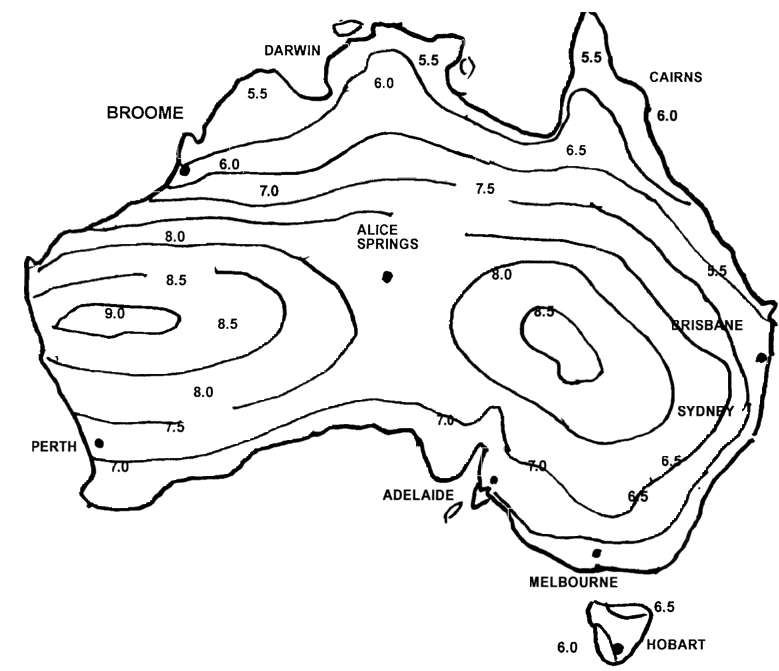How much solar capacity do I need
This article answers how much solar capacity do I need. It’s valid anywhere in the world that has enough sun. It can save you a lot of money.
The map below shows the amount you typically have available in Australia. Generally, solar is readily feasible where the daily amount exceeds 3.5. It is still feasible below that but needs a lot more solar capacity. The map shows the amount of sunlight in kilowatt/hours per day per square metre. This refers to any unshaded horizontal surface.
The solar industry, however, in its non-technical publications refers to one kilowatt/hour per day per square metre as 1 Peak Sun Hour. This is usually abbreviated to 1 PSH. The concept is akin to measuring rainfall in a rain gauge.

Solar irradiation in Australia. The units are kilowatt/hours per day per square metre. They are more commonly referred to as Peak Sun Hours.
How much solar capacity do I need – solar module alignment
Ideally, solar modules face due north (in the southern hemisphere) and due south (in the northern hemisphere). You do not need to take this too seriously. If you are more than 20 or so degrees out, adding about 10% more solar capacity (per every extra 10 degrees will compensate).
In terms of tilt, having the solar modules at your latitude angle results in the maximum yearly average. If you need more input in summer than winter, tilt them closer to horizontal. If you need more in winter than summer, tilt them more steeply.
Assessing current energy use
Your next stage is to assess how much electricity you need per day (and also of any rare peaks loads). You can simply look at your electricity bill and see. Then consider what you can do to reduce the draw.
Almost any existing home has 30 or more so-called wall warts. These are the little black boxes that enable you to switch appliances remotely. Many made prior to 2014 (and all cheap ones still) draw 3-6 watts even when the related appliance is switched off. That may not seem much. If, however, you 30 of them (some homes have more) that’s at least 90 to 180 watts, twenty-four hours a day (i.e. 2.16 to 4.32 kilowatt/hours a day. Worse, are items like 230 volt doorbells. One, personally experienced, drew a constant 40 watts, almost 350 kilowatt/hours a year. Yet activated a few times a week for a few seconds each time. Many a TV left on ‘standby’ all day draws far more a day than whilst being watched.
Items to replace – lighting
Replace all incandescent globes by LEDs. These provide better light at less than 25% of the same watts. LEDs last for many years: you recover far more their initially high cost over time. Be aware that ‘wattage’ no longer indicates light produced. Wattage is only a measure of the energy they draw. LEDs vary widely in this respect. Some are far more efficient than others. Their light output is shown in ‘lumens’. Their efficiency is thus lumens per watt. Because of this, LEDs that are cheaper to buy are likely to use far more long-term energy.
Items to replace – appliances
Recently made high-quality refrigerators draw far less energy. Replacing any made prior to about 2014 will save you money, in terms of how much solar capacity you need.
Air-conditioners likewise vary considerably in the amount of energy they draw. Assess their efficiency by looking for, or asking for, their CoP (Coefficient of Performance). This is the ratio of energy draw and work done. The higher the CoP the better. By and large units from 1.5 – 2.5 kW have the highest CoP. They cost more initially, but you will save over time.




